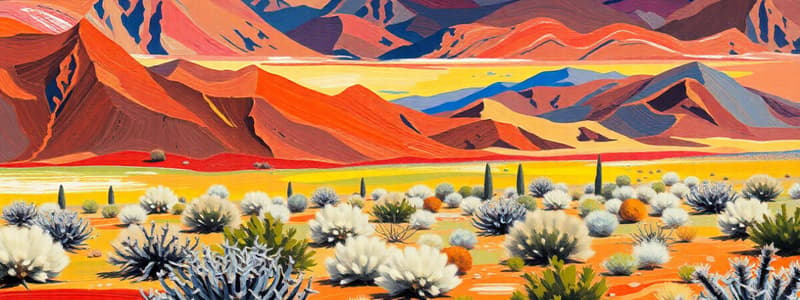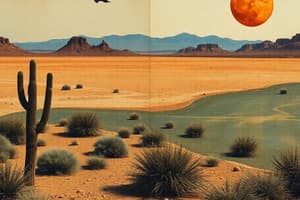Podcast
Questions and Answers
What is the maximum temperature that does not usually exceed during the day?
What is the maximum temperature that does not usually exceed during the day?
- 35° C
- 30° C
- 38° C (correct)
- 40° C
Evening temperatures are typically warm, averaging around 20° C.
Evening temperatures are typically warm, averaging around 20° C.
False (B)
What provides protection and enough shade for many animals during the night?
What provides protection and enough shade for many animals during the night?
Cactus or shrub
At night, many animals find protection in underground _____ where they are insulated from both heat and aridity.
At night, many animals find protection in underground _____ where they are insulated from both heat and aridity.
Match the animals with their associated behaviors:
Match the animals with their associated behaviors:
Which type of environment do ground cover plants, like shadscale and camel's thorn, thrive in?
Which type of environment do ground cover plants, like shadscale and camel's thorn, thrive in?
Grasshopper mice are primarily found in polar regions.
Grasshopper mice are primarily found in polar regions.
Name two animals that dig burrows.
Name two animals that dig burrows.
The primary fauna found in cold deserts includes __________ and __________.
The primary fauna found in cold deserts includes __________ and __________.
Match the following animals with their attributes:
Match the following animals with their attributes:
Flashcards are hidden until you start studying
Study Notes
Biomes
- Desert
- Temperatures vary greatly depending on location, from hot days to cool nights
- Rainfall - less than 25 cm per year, and may be unevenly distributed
- Soil - shallow and often loose, typically sandy
- Some deserts have soil with large amounts of salts
- Flora
- Plants are adapted to conserve water, such as cacti, shrubs and succulents.
- These plants are commonly found in areas with some rainfall.
- Fauna
- Desert animals are also adapted to conserve water, such as desert rodents, jack rabbits, lizards, snakes, and insects.
- Many desert animals use underground burrows for shelter and protection from the sun.
- Tundra
- Temperatures range from -34°C to 12°C
- Precipitation ranges from 15 to 25 cm per year
- Soil - Permafrost, or permanently frozen ground, is a key characteristic of tundra biomes.
- Flora
- Plants are adapted to short growing seasons and cold temperatures, such as mosses, lichens, grasses, and dwarf shrubs.
- Fauna
- Animals are adapted to cold temperatures and harsh conditions, such as caribou, reindeer, arctic foxes, polar bears, lemmings, and snowy owls.
- Alpine Tundra
- This tundra is located at high altitudes, meaning it occurs on mountains
- Temperatures are cold, windy, and arid
- Soil is thin and nutrient-poor
- Flora
- Plants are adapted to harsh conditions, such as grasses, small-leafed shrubs, heaths, and mosses and dwarf trees
- Fauna
- Animals are adapted to harsh conditions, such as mountain goats, sheep, elk, grouselike birds, and insects.
- Grassland
- Temperatures vary depending on location, but typically are hot in the summer and cold in the winter
- Precipitation ranges from 25 to 75 cm per year
- Soil
- Typically rich and fertile.
- Flora
- Grasses are the dominant plant type, along with wildflowers and herbs.
- Fauna
- Grassland animals are adapted to grazing, such as bison, antelope, zebra, and gazelle.
- Predators such as lions, wolves, and coyotes.
- Tropical Grassland (Savanna)
- Temperatures are hot year-round.
- Rainfall is seasonal.
- Soil is porous, with a thin layer of humus.
- Flora
- Grasses are the dominant plant type, along with scattered trees such as acacia, baobab, and river bushwillow.
- Fauna
- Savanna animals are adapted to grazing, such as elephants, giraffes, zebras, and buffalo.
- Predators such as lions, cheetahs, and hyenas.
Key Concepts
- Anti-freezing Chemical: A chemical that prevents the freezing of a plant's cells in cold temperatures.
- Specialized Root System: Roots that are adapted to access water and nutrients in harsh conditions.
- Transpiration Limit: The rate at which a plant can lose water through its leaves.
- Growing Close to the Ground: A strategy that allows plants to avoid cold temperatures and wind.
- Migration: Seasonal movement of animals from one location to another.
- Hibernation: A state of inactivity that allows animals to conserve energy during cold temperatures.
- Hides: Places where animals can find shelter and protection from predators and harsh conditions.
Studying That Suits You
Use AI to generate personalized quizzes and flashcards to suit your learning preferences.




